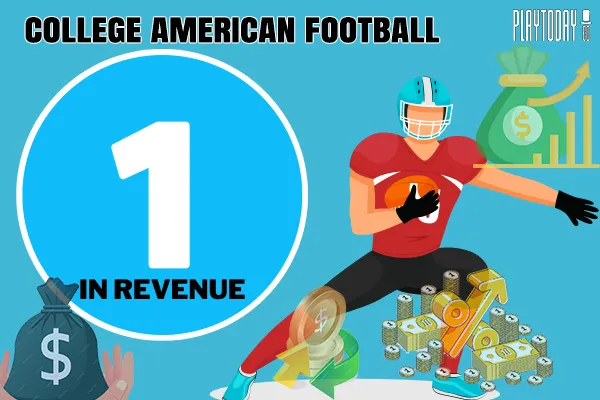College sports have become a staple in American culture, with millions of fans tuning in to watch their favorite teams compete. From football and basketball to lesser-known sports like fencing and water polo, college athletics bring in billions of dollars in revenue each year. In fact, college sports are such a big business that many universities rely heavily on these programs for financial stability.
In recent years, there has been a significant increase in college sports revenue, with some schools bringing in more than $100 million annually. This growth has not only impacted the financial landscape of universities but has also sparked debates over the ethics and fairness of amateur college athletes generating such significant profits.
In this article, we will dive into the latest statistics on college sports revenue, exploring its impact on universities, athletes, and the greater sports industry as a whole.

Overview of College Sports Revenue
Before delving into the specific numbers and trends, it’s important to understand what exactly college sports revenue encompasses. College sports revenue refers to the money generated by intercollegiate athletic programs, including ticket sales, television contracts, sponsorships, merchandise sales, and donations.
According to the National Collegiate Athletic Association (NCAA), Division I schools (the highest level of college sports competition) generated a total of $10.3 billion in revenue during the 2019-2020 academic year. This represents a steady increase from previous years, with revenue reaching $8.6 billion in 2015 and $9.2 billion in 2018.
Let’s take a closer look at the different sources of college sports revenue and how they contribute to the overall financial success of collegiate athletic programs.
Ticket Sales
One of the most significant sources of college sports revenue is ticket sales. Fans eagerly purchase tickets to attend games and support their favorite teams, especially during highly anticipated matchups or championship games. According to the NCAA, ticket sales accounted for 21% of Division I sports revenue in the 2019-2020 academic year, amounting to $2.1 billion.
Some of the most profitable college sports programs in terms of ticket sales include football and basketball. In 2019, the University of Texas brought in a whopping $156 million in football ticket sales alone, making it the highest-grossing program in this category.
Television Contracts
Television contracts are another major source of revenue for college sports programs. These contracts allow networks to broadcast games and events, which often come with hefty fees paid to universities. In the 2019-2020 academic year, television contracts accounted for 37% of Division I sports revenue, totaling $3.8 billion.
The most lucrative television contract in college sports is undoubtedly the one between the NCAA and CBS/Turner for the March Madness basketball tournament. This contract, which runs through 2032, is worth a staggering $19.6 billion and brings in significant revenue for universities participating in the tournament.
Sponsorships
Sponsorships are a crucial component of college sports revenue, with companies eager to align themselves with successful athletic programs. These partnerships can take the form of apparel deals, stadium naming rights, or even corporate sponsorships of individual teams or players.
In the 2019-2020 academic year, sponsorships accounted for 16% of Division I sports revenue, totaling $1.6 billion. The top sponsorships in college sports include Nike’s partnership with the University of Oregon, which brings in $12 million per year, and Under Armour’s deal with UCLA, worth $18 million annually.
Merchandise Sales
Another significant source of revenue for college sports programs is merchandise sales. Fans love to show their support for their favorite teams by purchasing jerseys, hats, t-shirts, and other branded items. In the 2019-2020 academic year, merchandise sales accounted for 11% of Division I sports revenue, totaling $1.1 billion.
The University of Texas again leads the pack in this category, with an estimated $95 million in merchandise sales annually. Other top merchandising schools include Ohio State University, the University of Michigan, and the University of Alabama.
Donations
Lastly, donations play a crucial role in college sports revenue, especially for smaller programs that may not have as much success in the other categories mentioned above. These donations can come from alumni, boosters, or other supporters of the university’s athletic program.
In the 2019-2020 academic year, donations accounted for 15% of Division I sports revenue, totaling $1.5 billion. The University of Notre Dame is known for its dedicated fan base and has consistently topped the list of schools with the highest annual donations to their athletic program.
Trends and Growth in College Sports Revenue

As mentioned earlier, college sports revenue has been steadily increasing over the years, with no signs of slowing down. Several factors contribute to this growth, including the popularity of certain sports, the success of individual teams, and the rise of media platforms like streaming services.
One significant trend in college sports revenue is the dominance of football and basketball. These two sports bring in the majority of the revenue for universities, with football generating approximately 40% of total revenue and basketball bringing in around 25%.
However, there has been a recent push for other sports to gain more recognition and generate more revenue. In particular, women’s sports and Olympic sports have seen an increase in funding and TV coverage. This not only helps to level the playing field for these athletes but also contributes to the overall growth of college sports revenue.
Another factor contributing to the growth of college sports revenue is the rise of streaming services. With more and more consumers cutting the cord on traditional cable, networks and conferences have turned to streaming services to broadcast games and events. This has opened up new revenue streams for universities and allowed them to reach a broader audience.
Controversies Surrounding College Sports Revenue
While college sports revenue brings in billions of dollars each year, it has also sparked much debate and controversy. One of the most significant issues is the question of whether or not college athletes should be paid for their contributions to these lucrative programs.
Currently, the NCAA does not allow athletes to receive any form of payment, as they are considered amateurs. However, with the constant growth in revenue and the increasing demands on athletes, many argue that they should be compensated in some way.
Some suggest that athletes should receive a portion of revenue generated by their individual sports, while others believe they should be able to profit off their name and likeness through endorsements and sponsorships. The ongoing debate continues to call into question the fairness and ethics of the current system.
Another controversial topic surrounding college sports revenue is how the money is distributed within athletic departments. While big-name schools like Alabama and Texas bring in millions of dollars each year, smaller schools often struggle to generate enough revenue to support their athletic programs fully.
This can create an imbalance within college sports, where certain schools have significantly more resources and advantages than others. Critics argue that this goes against the spirit of amateur athletics and perpetuates a hierarchy within college sports programs.
Impact of College Sports Revenue on Universities and Athletes
The rise of college sports revenue has undoubtedly had a significant impact on universities and athletes alike. For universities, the influx of money has brought about both positive and negative effects.
On one hand, successful athletic programs can bring in substantial revenue that can be used to fund other areas of the university. These programs can also bring in more students and boost school spirit, leading to increased alumni donations and overall institutional success.
However, the pressure to maintain a profitable sports program can also have negative consequences. Universities may prioritize athletic success over academic achievement, and the intense competition can lead to issues like recruiting violations and academic scandals.
For athletes, the impact of college sports revenue is a bit more complex. On one hand, they are not allowed to receive any financial compensation for their contributions to these lucrative programs. On the other hand, being a part of a successful athletic program can open up opportunities for future careers in professional sports or other industries.
Additionally, some argue that the demands placed on student-athletes to perform at a high level while balancing academics and training can be detrimental to their well-being. The pressure to bring in revenue for the school can take a toll on their mental and physical health, leading to burnout and injury.
Future Projections for College Sports Revenue

As we look towards the future, it’s clear that college sports revenue will continue to grow and play a significant role in the sports industry. Some experts predict that revenue will reach $14 billion by 2025, with football and basketball remaining the top sources of income.
However, there are also potential roadblocks that could hinder this growth. The ongoing debate over compensating college athletes could potentially lead to changes in the current system, which could impact revenue streams for universities. Additionally, the recent disruptions caused by the COVID-19 pandemic have had a significant impact on college sports revenue, with many schools facing financial struggles as a result.
Conclusion
In conclusion, college sports revenue has seen a significant increase in recent years and continues to be a lucrative business for universities and the sports industry as a whole. With ticket sales, television contracts, sponsorships, merchandise sales, and donations all contributing to the overall revenue, it’s no surprise that college sports have become such a big business.
While there are certainly controversies surrounding this growth, there is no denying the impact that college sports revenue has on universities, athletes, and fans. As we continue to see changes and developments in the sports industry, it will be interesting to see how college sports revenue evolves and impacts the future of collegiate athletics.
